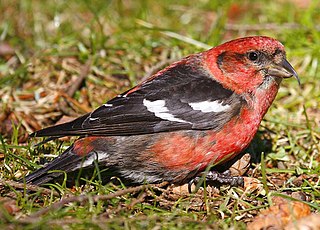
Larches are deciduous conifers in the genus Larix, of the family Pinaceae. Growing from 20 to 45 metres tall, they are native to much of the cooler temperate northern hemisphere, on lowlands in the north and high on mountains further south. Larches are among the dominant plants in the boreal forests of Siberia and Canada. Although they are conifers, larches are deciduous trees that lose their needles in the autumn.

The two-barred crossbill or white-winged crossbill is a small passerine bird in the finch family Fringillidae.

Cercocarpus, commonly known as mountain mahogany, is a small genus of at least nine species of nitrogen-fixing flowering plants in the rose family, Rosaceae. They are native to the western United States and northern Mexico, where they grow in chaparral and semidesert habitats and climates, often at high altitudes. Several are found in the California chaparral and woodlands ecoregion.

Larix decidua, the European larch, is a species of larch native to the mountains of central Europe, in the Alps and Carpathian Mountains as well as the Pyrenees, with disjunct lowland populations in northern Poland and southern Lithuania. It is widely naturalized in Scandinavia. Its life span has been confirmed to be close to 1000 years but is more often around 200 years. It is claimed that one of the larches planted by the second Duke of Atholl at Dunkeld in 1738 is still standing.

The International Larix Arboretum is a small arboretum of 1.2 acres (4,900 m2) dedicated to the scientific study of the larch (Larix) species. It is located within the Coram Experimental Forest, 30 yards SE of the Hungry Horse Ranger station at 10 Hungry Horse Drive Hungry Horse, Montana. The Arboretum is open to the public, without charge, during daylight hours from April to October.

Larix sibirica, the Siberian larch or Russian larch, is a frost-hardy tree native to western Russia, from close to the Finnish border east to the Yenisei valley in central Siberia, where it hybridises with the Dahurian larch L. gmelinii of eastern Siberia; the hybrid is known as Larix × czekanowskii.

Peavy Arboretum is an arboretum operated by Oregon State University and located on Arboretum Road, Corvallis, Oregon. It is open to the public daily without charge.

Larix gmelinii, the Dahurian larch or Gmelin larch, is a species of larch native to eastern Siberia and adjacent northeastern Mongolia, northeastern China (Heilongjiang), South Korea and North Korea.

Larix × czekanowskii is a larch species, likely a hybrid between Siberian larch and Dahurian larch.

Larix potaninii is a species of conifer in the family Pinaceae. It is found in China and Nepal. The one of southernmost species of the genus Larix, the range of Larix potaninii extends southward almost to 27° N.
Larix gmelinii var. olgensis, synonym Larix olgensis, the Olga Bay larch or Olgan larch, is a variety of larch. The variety is named after Olga Bay in the Sea of Japan. The common name in Japanese language is 満洲唐松. The common name in Chinese is 黄花落叶松. This variety occurs in Central Sikhote-Alin, and rarely occurs in North Korea, and Jilin and eastern Heilongjiang provinces of China, between 500 and 1100 metres in elevation.

Sphinx morio, the larch hawk moth or Asian pine hawkmoth, is a moth of the family Sphingidae. It is found in Russia, the Korean Peninsula, Japan and China.

Ranunculus gmelinii, Gmelin's buttercup or small yellow water-crowfoot, is a species of flowering plant in the buttercup family, Ranunculaceae. It is native to northern North America, where it occurs across Canada and the northern and higher-elevation regions of the United States. It is also present in Eurasia.

Cydia illutana is a small moth of the family Tortricidae. It is found from western and central Europe, north to Scandinavia and east to Russia (Siberia).
Coleophora obducta is a moth of the family Coleophoridae. It is found in Japan and Russia (Baikal).
Coleophora sinensis is a moth of the family Coleophoridae. It is found in Shanxi and Hebei provinces of China.

Erannis jacobsoni, or Jacobson's spanworm, is a moth of the family Geometridae. The species was first described by Alexander Michailovitsch Djakonov in 1926. It is found in Europe and Asia.

Vitim Nature Reserve is a Russian 'zapovednik' in the mountains 400 km northeast of Lake Baikal in the Irkutsk region of Siberia. It covers the upper reaches of the Vitim River, a left tributary of the Lena River. The reserve protects a wide variety high-altitude, continental climate flora and fauna complexes: larch taiga, cedar thickets, mountain tundra, and sub-alpine meadows of the Delyun-Uran and Kodar Mountains. The reserve is located in the southeast of the Bodaybinsky District of Irkutsk Oblast, 150 km east of the regional city of Bodaybo. It was formally established in 1982, and covers 585,838 ha (2,261.93 sq mi).

Ips subelongatus, known generally as larch bark beetle or oblong bark beetle, is a species of typical bark beetle in the family Curculionidae. It is considered near indistinguishable from Ips cembrae except for the species of tree it chooses as a host and through DNA analysis. The species of tree it dwells in are Larix sibirica, Larix gmelinii, Larix leptolepis and Larix gmelinii var. olgensis. The beetle is found in the Asian part of Russia, China, Japan, the Korean peninsula and Mongolia.
















